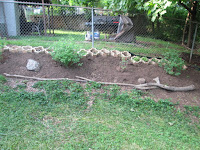COVID wasn't the only outbreak to hit New Jersey in 2021. Last summer, we also experienced an incursion of the beautiful but destructive spotted lanternfly. These pesky critters lay their eggs on trees, and when they hatch, the nymphs feed on their sap and excrete a substance that can cause fungal growth. At the height of the infestation, Brian and I were squashing a dozen or more of these critters every time we went out for a walk.
However, squashing them one by one can only do so much. The really important thing, officials told us, was to get rid of the plants most likely to host the bugs, particularly tree of heaven. This plant is itself an invasive species, and a particularly common weed in our area; before I knew its name, I referred to it as "stink weed" because of its distasteful smell, which is something like a cross between peanut butter and skunk. We'd always made a point of uprooting it whenever we found it in the yard, but unfortunately, a few of the tricksy weeds had managed to hide themselves away behind the shed, where we didn't spot them until they had grown to tree-like proportions. So when the lanternflies invaded, Brian went out there with a saw and cut them down, while I busied myself trying to kill as many as possible of the hundreds of lanternflies scattered across their surface.
This left us with several fairly substantial lengths of wood, each a few feet long and ranging from about two to six inches in diameter. At first, Brian propped these up against the shed to serve as a "decoy" for other lanternflies. And we did continue to find, and squash, more bugs on these logs for a week or so afterwards. But eventually, the bugs were gone and the wood remained, just sitting there with no obvious purpose.
Fast forward to this spring, as we're getting our garden ready for planting. Along with all the weeding, we're making note of things that need to be repaired, such as the boards that form the front border of our rhubarb patch. They were originally placed on their edges and partially buried to make a sort of wall, but the underground portions have rotted away, causing the wall to collapse inward. And as I was trying to figure out if there was any way to fix this without buying new boards, I noticed those tree-of-heaven logs still leaning there against the shed and thought, well, why not?So I hauled the boards out and replaced them with some of the longer tree-of-heaven sticks. These make a rather rustic-looking barrier that actually looks nicer, to my eyes, than the old boards, and will probably hold up pretty well since they've still got the bark on them. That used up about half of the wood.
I didn't think of a use for the rest of it until this weekend, when I was attempting to spread mulch around the honeyberry bushes on the north side of the yard. I say "attempting" because this is a particularly awkward spot for mulching; the slope is very steep, so the mulch has a tendency to slide downhill. Rather than staying around the bushes, where it's needed, it piles up at the bottom, leaving unsightly patches of bare ground cloth behind.
However, there are some spots on that slope where the mulch does stay put. There are a couple of large boulders (some natural rock, some concrete) buried in the side of the hill that impede its downward slide. So, in an attempt to keep the mulch contained, I started hunting around for more rocks and other heavy objects that I could use to shore up the slope. But I was only able to find one sizeable rock and a few brick fragments, so I decided to try grabbing the remaining tree-of-heaven logs and using them to make a sort of border near the bottom of the slope.I'm not sure how well these will work to corral the mulch. They may end up sliding down the slope themselves, or the mulch may tumble over and under them. But they're probably better than nothing, and even if they do no good at all, it gets them out of the way.
It's not exactly a major money-saver. But it is about as neat an embodiment of the ecofrugal motto "Waste not, want not" as you could ask for.






No comments:
Post a Comment